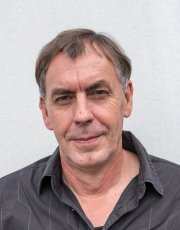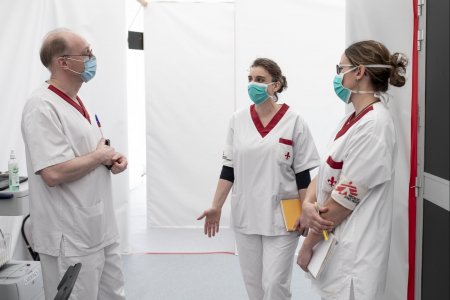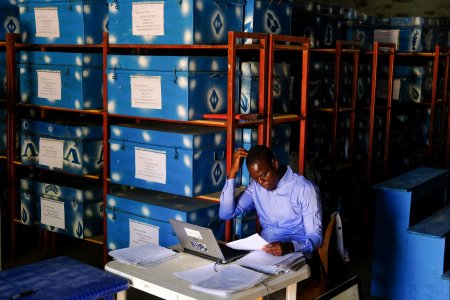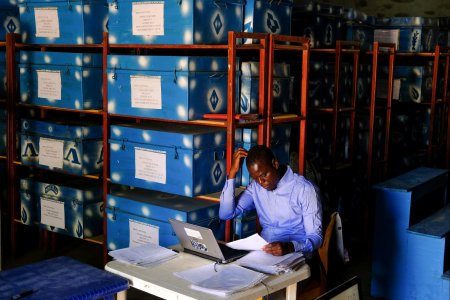
I do not clap at 8 o’clock
Jean-Hervé Bradol
The biggest oversight in the response to this epidemic has been the EHPADs. For the staff, the directive was clear: continue to work and provide an alternative to hospitalisation. No matter the conditions. For the residents, it was to die alone without treatment to alleviate their suffering.
In late March and early April, we were among the members of Médecins Sans Frontières concerned about the ban on visitors to France’s Établissements d'hébergement pour personnes âgées dependants, or EHPADs – residential care homes for the elderly. Then the Minister of Health asked the residents to stop leaving their rooms. They had to be protected from catching Covid-19 from their visiting friends and relatives or other residents. Yet our experience in disasters, including epidemics, has taught us that during epidemics, people living in closed settings (orphanages, prisons, refugee camps, psychiatric care facilities, migrant detention centres, juvenile detention centres, etc.) are in the worst situation. Though we claim that we are isolating them from the rest of the world for their own, or society’s, good, these people are destined for more severe illness, even death, in far higher proportions than those allowed to move freely. In our experience, these situations cannot be ameliorated without protected – and above all broader – exposure to the outside world by allowing people from the outside to visit and allowing some of the residents to go out.
Around this same time, one of our fellow MSF doctors was also a member of the Covid-19 crisis cell at the Henri Mondor University Hospital in Créteil, in the Val-de-Marne département. At a meeting, the dean of the Paris 13 Faculty of Medicine expressed concern about the fate of the elderly in this epidemic, particularly those living in institutions. A small geriatric Covid-19 unit led by a post-doctoral fellow in geriatrics and including a SAMU physician and some medical students was formed with the aim of getting in contact with the department’s seventy EHPADs.
Through the intercession of our MSF colleague, two nurses and two doctorsThis author included.from our association offered to visit any EHPADs that wanted them. The objectives were to express our solidarity with colleagues facing a crisis situation, take stock of the reported cases and deaths, inventory the available human and physical resources, share medical and scientific information about the infection, explain infection prevention measures, examine patients, and prepare anticipatory prescriptions in case a resident’s condition should deteriorate when there were no paramedical or medical staff on-site.
In coordination with SAMU 94, the crisis cell set up a phone number to respond to requests for geriatric care coming from outside the hospital system. In addition to improving care for the elderly, it was clear from the first meeting that the initiative’s other objective was to protect the hospital and SAMU from a flood of patients from the EHPADs, as families were pushing to get loved ones hospitalised when their health status worsened.
It was clear from our first EHPAD visits that we had gotten there too late. Many of the residents were already infected, and several had already died from Covid-19. And though the residents had been isolated, almost nothing had been done to prevent virus transmission among the staff – which watched us arrive in our head-to-toe PPE at a time when they had almost no access to such equipment.
The reality was that at the time it was just difficult to procure masks, alcohol-based gel, and protective clothing. MSF couldn’t get us any. It was only through one of our colleague’s resourcefulness that we ourselves had any PPE. That colleague had been in private practice until March, when he fell ill himself and closed his practice to prevent it from becoming a hotspot. MSF put an end to our collaboration with him, explaining that working with a private practitioner was, on principle, a problem for a humanitarian medical association, for which collaborating with a privately-paid colleague was inconceivable. With that we lost invaluable help, illustrating the degree to which associations can sometimes become more rigid than government agencies.
For EHPAD staff, the directive was clear; they were to continue to work and provide an alternative to hospitalisation that – due to lack of room – had become impossible for EHPAD residents. This was regardless of the conditions, with no PPE or special training, little supervision by too few nurses on-site only during the daytime, and little support from physicians or coordinators, often sick themselves. The rare times that virologic testing was available, the facility managers waited for the results in fear that too many staff members would be put on leave. In some cases, staff members who tested positive – with or without minor clinical signs – were encouraged to keep working despite the risk to themselves, their colleagues, and the residents. Under those circumstances, confining the residents led to caregivers being infected by residents (and vice-versa), turning the facilities into hotbeds of the virus.
Promoting infection prevention seemed futile under those conditions. We did, however, stress the steps that caregivers could take to avoid infecting household members when they came home from work. We knew that the lack of PPE for staff was a sensitive subject. When MSF leaders mentioned it publiclyApril 17, 2020 AFP story, the director of Henri Mondor hospital terminated our partnership and fired our MSF colleague, a member of the hospital’s crisis unit. Action is currently continuing in other Île-de-France departments.
Neglected in the response to the epidemic
Given the situation in the EHPADs, it is hard not to feel deeply uncomfortable when political leaders and university hospital managers tell us that confinement helped prevent a flood of patients from overwhelming the capacity of the intensive care units, where the number of beds has trebled. As the Director-General of the MoH reminds us at his daily press conference, this is the primary indicator used to guide the response to this epidemic. To prevent the number of severe cases from becoming so high that it exceeded ICU capacity, the government took a radical step costing more than a billion euros a day; it ordered the general population to stay home to reduce contact between individuals and hence the number of new cases.
ICU heads expressed their support for that policy in the media. According to them, this prevented their having to choose which patients – out a group of patients all presenting clinical findings that justified admission to intensive care – would not be given an ICU bed due to a lack of space. They proudly claimed that they had filled the beds using the usual criteria. According to some, doing things differently in this extraordinary situation would have meant choosing who would live and who would die.
Modifying the criteria used to allocate resources in disaster situations is not, however, the same as granting divine powers, but quite simply remembering that medical resources are always limited and that their allocation is context-dependent. When circumstances change, doctors have to adjust how resources are distributed between the different categories of patients. Not to downgrade their practices, but to optimise outcomes based on what the new situation requires.
This lack of flexibility by the portion of the university hospital elite asserting that they didn’t want to change these priorities has created a catastrophic injustice. EHPAD residents lost access to hospital-based human and physical resources. The problem is not that they didn’t have access to mechanical ventilation when they could no longer breathe on their own. With their advanced age and comorbidities, that type of intensive care is too often both a failure and a painful ordeal. With a few exceptions, what the EHPAD population needed – treatment-wise – were standard inpatient beds where they could be given oxygen (and related treatments) or palliative care to make their last days as painless as possible. Dying old and sick is one thing. Dying alone without treatment to alleviate suffering is another. Only a quarter of the residents who died did so at a hospitalSanté publique France (May 7 bulletin). To EHPAD staff and families demanding hospitalisation, the hospital replied that there was no room, and that in any case their relative or friend would likely get oxygen lying on a gurney in the emergency department corridor, a treatment they could as just well get, more comfortably, in their own rooms. Yet the reality is that there are no doctors or nurses in these facilities to administer and monitor the treatment in the evening or at night.
Under those conditions, half of France’s 25,661 Covid-19 deaths occurred among its approximately 600,000 EHPAD residentshttps://www.insee.fr/fr/statistiques/3676717?sommaire=3696937; though less than 1% of the population, they accounted for 50% of the Covid-19 deathsSanté publique France (May 7 bulletin). The fact that the Directorate General of Health didn’t release the number of EHPAD deaths until April 7 illustrated a cruel neglect. Confining the residents in these facilities – supposedly to protect them – has only amplified the catastrophe, while hiding it from view.
To cite this content :
Jean-Hervé Bradol, “I do not clap at 8 o’clock”, 10 mai 2020, URL : https://msf-crash.org/en/blog/medicine-and-public-health/i-do-not-clap-8-oclock
If you would like to comment on this article, you can find us on social media or contact us here:
Contribute




Add new comment